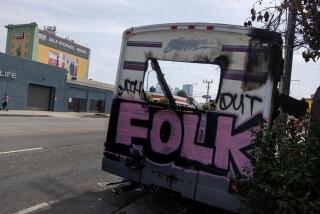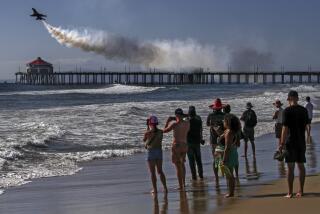California Commute: Effectiveness of state’s ‘parking cash-out’ program is unclear
To reduce air pollution and traffic congestion, California legislators passed an innovative law in 1992 to encourage solo commuters to get out of their cars and bike, carpool or take public transit to work.
The measure, by then-Assemblyman Richard Katz (D-Panorama City) required certain companies, government agencies and other employers to offer their workers cash to cover commuting costs in lieu of giving them free parking, one of the main incentives to drive to work alone.
Participants soon found that the law was easy to implement and that they could cut the expense of leasing space or lots for parking. Workers who chose to give up their spaces liked the cash payments — up to $150 to $200 a month in some cases. What money was left over after transit passes or carpooling expenses, they could pocket.
But 23 years after the law was enacted, it is unclear how effective the so-called “parking cash-out” program has been.
The California Air Resources Board, the administrator, does not know how many employers or employees are participating, nor does it periodically survey workplaces to ensure compliance, although performance assessments were recommended more than a decade ago by the Legislative Analyst’s Office, a nonpartisan oversight agency.
Analysts noted that more outreach was necessary and that the eligibility rules were so narrowly drawn that the law applied to only about 3% of the 11 million free parking spaces provided by employers statewide.
“I’m disappointed,” said Donald Shoup, an urban planning professor at UCLA and parking policy expert who developed the concept. “Parking cash-out is the simplest, cheapest and fairest way to reduce air pollution, traffic congestion and CO2 emissions in California.”
Air board officials defended the program, saying their agency gets about 20 inquiries a month from employers, a substantial indication that use of the law is expanding and that people are aware of it.
Karen Magliano, head of the board’s air quality planning and science division, said the law does not require her agency to gather data about employers or check to see if they are obeying the law, although it has the power to fine employers up to $500 per vehicle if requirements are not followed.
“Our focus has been facilitating compliance through outreach and education,” Magliano said. “We provide guidance to employers to help them set up programs, and we partner with the state’s Economic Development Department and local air quality management districts across the state.”
The cash-out law applies to employers that have least 50 employees and provide leased or subsidized parking spaces for their workers. The number of spaces must be reducible without penalty by the landlord. The employer must be able to calculate the cost of participating in the program, and the parking spots involved are not for van pools or car pools.
Workers who take the cash-out must pay income tax on it, but employers can eliminate the cash payment and provide a mix of transit passes, ride-share subsidies and cash to reduce the tax liability.
Some research indicates that the program is working where it is implemented. In 1997, Shoup studied eight Los Angeles area employers that had a total of 1,694 workers.
He found that the percentage of employees who drove to work dropped from 76% to 63%. Carpooling rose from 14% to 23%, transit use increased from 6% to 9% and walking and biking increased from 3% to 4%.
In addition, parking demand fell 11%, and driving to work alone declined anywhere from 4% to 29%, depending on the employer.
Before enrolling in the cash-out program, the average monthly parking or commuting subsidy per employee was $72. After enrolling, the cost rose to $74. However, one firm that eliminated parking subsidies saved $70 a month per worker.
The law firm of Jeffer, Mangels, Butler & Mitchell, in Century City was one of the early participants. In the mid-1990s, employees who gave up a free parking space received $50 in bus passes, plus $100 a month.
Today, about 12 of 185 staff members are in the program. They receive $215 a month, the cost of providing each a parking space in the office building.
“I love it,” said Tom Fleming, the director of information services. “I can take mass transit. My car only has limited use on weekends.”
Fleming has participated in the cash-out program for 14 years. Eligible for a senior discount, he buys a 30-day Metro bus pass for $20, but, Fleming says, it ultimately costs him only $8 because of a transit subsidy from West Hollywood, where he lives. The rest of the payment is his.
Shoup said the cash-out program is especially compelling in densely populated urban cores plagued with air pollution and heavy traffic, such as downtown Los Angeles.
Studies show that more than 90% of commuters in Los Angeles and Orange counties receive free parking at work, a significant obstacle for public policies designed to encourage transit use and reduce traffic congestion, energy consumption and vehicle emissions.
“It’s disappointing to hear that the Air Resources Board has taken such a laissez faire approach,” said Rebecca Long, who wrote the report for the legislative analyst. “This calls out for another bill. The Legislature needs to push them more, considering [that] when implemented, the idea is effective.”
Over the years, Shoup has repeatedly asked state officials to improve the air board’s outreach and enforcement of the cash-out law. He suggested that its use could be expanded by letting companies participate if they have as few as 10 employees instead of at least 50.
According to the latest state economic data, there were about 196,000 employers in California with between 10 and 49 workers in 2013 and about 55,000 employers with 50 or more.
“That would make a lot of sense,” said Katz, who is now a government consultant and an alternate board member for the Metrolink commuter railroad. “If the cash-out program is not effective, we should kill it or make it effective.”
Follow @LADeadline16 for transportation news.
More to Read
Sign up for Essential California
The most important California stories and recommendations in your inbox every morning.
You may occasionally receive promotional content from the Los Angeles Times.











